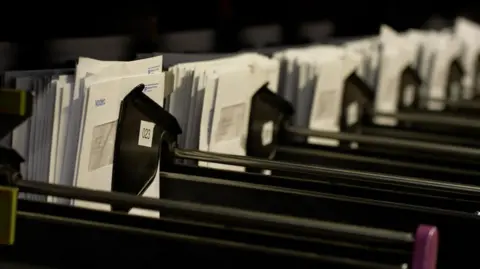 BBC
BBCSorting through bundles of letters, small packages and magazines, Herman Moyano is getting ready for his early morning post round.
Cargo bikes and vans stream out from the depot, just north of Copenhagen, as Herman departs on his scooter.
For the past seven years he’s been delivering mail for Denmark’s national postal service PostNord.
“I used to think that all the people are waiting for something, a special letter, a special communication, a special package,” he says.
However, Herman has noticed the loads getting lighter, and rather than letters, these days it’s mostly bills and bank statements.
“I have seen the mail going down gradually. But that’s picked up pace over the last couple of years,” he adds. “Nowadays, it seems… it’s going really, really down.”
The steep decline in letter volumes has been driven largely by digitalisation, and PostNord announced in March, that it will cease letter services at the end of the year.
It will bring to an end four centuries of letter deliveries by the state-owned operation.
A third of its workforce is being let go, as it sheds 2,200 positions in its loss-making letter arm. Instead it will focus on its profitable parcel business, creating 700 new roles.
“Danes hardly receive any letters anymore. It’s been going down for years and years,” says Kim Pedersen, chief of PostNord Denmark. “They’re receiving one letter a month on average, it’s not a lot.”
“On the contrary, Danes love to shop online,” he adds. “Global e-commerce is growing significantly, and we are moving with it.”
Fifteen years ago, PostNord operated several enormous letter-sorting facilities, but now there’s just one on the western outskirts of Copenhagen.
Since 2000 the volume of letters the business handles has declined by more than 90%, from around 1.4 billion, to 110 million last year, and it continues to fall rapidly.

As PostNord prepares to cease letter deliveries, 1,500 of its red post boxes are being removed from Danish streets. However, few locals in the capital appear to use them much.
Copenhagen resident Nikolaj Brøchner Andrès says he cannot recall when he last sent a letter. “I don’t think I’ve sent a letter in years… I’m not even sure how to do it anymore, to be honest.”
From email and cashless mobile payments, to digital health cards carried by smartphone, there’s an app for almost everything in Denmark, and it’s one of the world’s most digitalised nations.
The government has embraced a “digital by default” policy, and for more than a decade correspondence with the public has been carried out electronically.
According to the OECD’s 2023 Digital Government Index, it ranks second only to South Korea.
“We are facing this natural evolution of a digitalised society, earlier than maybe some other countries,” Mr Pedersen explains. “In Denmark we are maybe five or 10 years ahead.”
The high cost of sending a letter in Denmark is also a contributing factor behind its decline.
In 2024 a new law opened up the postal market to private competition, and took away its exemption from the country’s 25% rate of VAT, so the price of a PostNord stamp jumped to 29 Danish krone ($4.55; £3.35) per letter.
“That made [volumes] drop even further faster,” Mr Pedersen points out.
The big fall in the number of letters being posted is replicated Europe-wide, says postal sector expert Hazel King, editor of the magazine Parcel and Postal Technology International.
“Letters across Europe have been declining for years,” she says. “I think PostNord’s decision is a reflection of how the whole market has gone, and the way the consumer is moving.”
Physical mail has dropped by 30% or more from its historical peak, across all major global markets, according to a report by consultancy firm McKinsey.
In Europe, Germany and Switzerland have seen the slowest [letter] decline, says Florian Neuhaus, who co-authored the study. “It’s only 40% there, but everybody else sees around a 50 to 70% decline [since 2008].”
There’s a similar pattern in the United States, where mail has also declined 46%.
“Clearly this is driven by digitalisation and how people communicate in general,” adds Mr Neuhaus. “Overall, the economics in letters are just getting worse and worse.”

In March, Germany’s Deutsche Post said it was slashing 8,000 jobs, and cost-cutting efforts at the UK’s 500-year-old Royal Mail will see it scale back second-class letter deliveries to only every other weekday, while targets for first class delivery times have also been lowered.
“I do think that we will see the end of letters in the mainstream,” says Ms King. “However, I’m not sure we’ll ever see zero letters, pointing to a necessity to protect medical letters, and services for the elderly, disabled and rural areas.
In Denmark letter deliveries won’t actually come to an end. Instead private delivery firm DAO is to step into the gap with its own nationwide service.
Yet DaneAge, an advocacy group for the elderly, fears that older people may struggle with the changes to letter deliveries.
“Most elderly live in small towns and in the rural places,” says Marlene Rishoj Cordes, one of its senior consultants. “When there’s not as many post boxes around, they will have a harder time delivering mail. “
Meanwhile, the trade union that represents postal workers, 3F Postal Union, has voiced concerns that rural services may worsen.

DAO strongly disagrees with these fears. It’s historically a newspaper and magazine distributor with nationwide reach, and has become one of the country’s major parcel couriers.
A recent survey found DAO’s deliveries were faster, with more letters arriving within five days than PostNord.
“We are coming to all households, and we are in the rural areas in the whole country,” assures its chief executive Hans Peter Nissen.
Last year it handled 21 million letters and, from 2026 following PostNord’s exit, DAO expects to take on 30 to 40 million more.
Its staff will deliver letters directly, while doing newspaper and parcel rounds, Mr Nissen explains. Meanwhile, post is collected from mailboxes inside affiliated shops, though doorstep pick-ups can be booked online or over the phone, for a small additional fee.
DAO plans to install a new sorting machine, and add around 250 more staff, to its 2,500 workforce.
As physical letters decline across Europe, Denmark’s experience perhaps offers a window on the future.
In this increasingly digital world, however, there are still many who find joy in sending and receiving personal letters, including Copenhagener, Jette Eiring Williams, who writes to her daughter overseas.
“I think the young generation wants that old school feeling,” Ms Williams says. “She loves the physical touch of something, so not just an email or a text anymore.”

